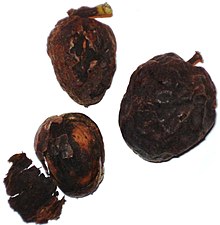Walnut fruit fly
| Walnut fruit fly | ||||||||||||
|---|---|---|---|---|---|---|---|---|---|---|---|---|

Walnut fruit fly ( Rhagoletis completa ) |
||||||||||||
| Systematics | ||||||||||||
|
||||||||||||
| Scientific name | ||||||||||||
| Rhagoletis completa | ||||||||||||
| ( Cresson , 1929) |
The walnut fruit fly ( Rhagoletis completa , syn .: Rhagoletis suavis ssp. Completa ) is a fly from the family of bored flies (Tephritidae).
It is a from North America originating pest of walnut plants (and rarely on peach ). The fly is currently spreading as a neozoon in Europe .
features
The flies become 8 to 10 millimeters long. They have a yellowish to whitish body with brownish stripes. The wings are transparent and lined with three black bands - the one at the wing tip has a "V" shape. The wing drawing is probably a mimicri and, seen from behind, reminds of the front pairs of legs of a jumping spider (possibly of the Zygoballus sexpunctatus ) through the movements when walking on the fruits and walnut leaves .
The larvae reach a length of four to six millimeters and have a yellowish colored body with black mouthparts.
Way of life
The larvae of the flies develop in the fruits of various walnut plants , in North America and the like. a. the black walnut , Juglans californica and Juglans hindsii . In Europe, the real walnut ( Juglans regia ) in particular is attacked, and rarely peaches .
The females of the walnut fruit fly lay a total of up to 400 eggs and up to 15 eggs per nut as a clutch beneath the epidermis of immature nuts. In addition, after oviposition, they release a pheromone that serves as a label for other females. The yellowish larvae hatch after about five days. They eat in the pulp of the walnut (the green shell above the nut) for three to five weeks. Then the now maggot-like animals leave the walnuts, drop to the ground and dig a few inches deep into the ground, where they pupate and hibernate. Most flies hatch between July and September of the next year - some also remain in the ground for two or more years.
Harmful effect

The flesh of the infected nuts begins to rot due to the larvae eating and turning black - it takes on a soft consistency or sometimes dries up. Some of the damage is considerable. As a rule, up to 3/4 of the yield of a tree is affected.
The later the infestation occurs, the better the nut can develop. However, the pulp can hardly be completely removed, which is why consumption becomes unattractive. In addition, the shelf life of the nuts is limited.
Distribution in Europe
The walnut fruit fly was introduced as a neozoon from North America and was first discovered in Switzerland in the late 1980s . From there it first spread to the south ( Italy ) and southeast ( Slovenia and Croatia ). In 2004, the first infestation in Germany was found in the Freiburg im Breisgau area - from there the fly spreads to the north, where - following the course of the Rhine - it has reached Hesse and the area around Cologne . The first infestation in France was found in 2007, the first in Austria in 2008. The fly has also been detected in the Berlin-Brandenburg area since autumn 2013 and led to significant crop failures in 2015.
Combat
Insecticides for combating the walnut fruit fly have not yet been approved in Europe.
Combat is difficult and time-consuming. The most important measure is the destruction of the infected fruit, whereby these should not be disposed of on the compost heap, but either disposed of in the residual waste or, if necessary, burned. Another measure is to cover the ground under the infested walnut tree, once in early summer (from around mid-June) before the flies hatch, in order to prevent the flies from hatching or escaping (because they overwinter in the ground as a pupa). On the other hand, the ground should be covered before the fruit falls in summer / autumn (around the end of August to mid-early / mid-October) so that the larvae cannot reach the ground to pupate or overwinter.
Also, hanging up yellow signs when the insects are flying (early July to August) can lead to a reduction in population density, but with this method the bycatch of other insects is quite large. In addition, only a reduction in the number of flies can be achieved with yellow panels, but not sufficient control.
Web links
- Walnut fruit fly - a new, previously unknown pest, Baden-Württemberg Ministry for the Environment, Climate Protection and the Energy Sector
- Items from the IPM the University of California (English)
- LE Carroll, AL Norrbom, MJ Dallwitz, and FC Thompson. - Pest fruit flies of the world - larvae (English)
- Walnut fruit fly in the Hortipendium Wiki
- Video: The larvae of the walnut fruit fly leave the fruit
Individual evidence
- ↑ Article by Helmut Riedel on Walnut husk fly on the Washington State University website
- ↑ in Thurgauer Bauer , issue 44, 2009 (article online)
- ↑ Current pathogens in the urban area of Berlin - walnut fruit fly , Plant Protection Office Berlin November 1, 2013.
- ^ Ministry for the Environment, etc. Baden-Württemberg
